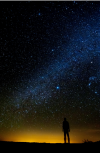No- this is not from a drone! But I am working on my Montana video and in the meantime, still working on some astro shots. I thought I'd pass these along.
I’ve been studying and working on producing this image for years! I have had many failures but this one finally was my first success.
This image was also shot at the top of a dark Montana mountain top, the darkest place I could find in Big Sky,Montana. It was shot between 10:45PM and 1:00AM. Aug. 29- the last new moon.
Most of my astro-photography consists of only starry skies or a vertical Milky Way. In fact, there is a Milky Way up there which stretches from horizon to horizon but can only be captured by using an “L” bracket to hold the camera vertically to encompass more sky and ground. Then, a series of vertical and overlapping shots is taken every 15 degrees on the tripod head. The straight lines are shooting stars. Unfortunately I cannot identify the bright spots, either planets or stars. Any help on this is welcomed.
In the panorama shown here, I shot at least 7 vertical shots with a 15 degree overlap. All of these images were then brought into Adobe Photoshop and “stitched” together. Once the completed panorama was completed, color adjustments were made to darken the sky and reduce the noise using Topaz Denoise.
I have also included only another shot of one arm of the Milky Way looking directly south.
I am now back in Miami and soon will begin putting together my Montana video.
Specs:
Nikon D750
Nikkor 14-24mm f/2.8 lens at 14mm and f/2.8
Shutter speed 20 second exposure
ISO 2000
Really Right Stuff tripod
“L”Bracket- camera vertical, 7 shots overlapped 15 degrees on tripod head
Processed Adobe Photoshop and Topaz Denoise
I’ve been studying and working on producing this image for years! I have had many failures but this one finally was my first success.
This image was also shot at the top of a dark Montana mountain top, the darkest place I could find in Big Sky,Montana. It was shot between 10:45PM and 1:00AM. Aug. 29- the last new moon.
Most of my astro-photography consists of only starry skies or a vertical Milky Way. In fact, there is a Milky Way up there which stretches from horizon to horizon but can only be captured by using an “L” bracket to hold the camera vertically to encompass more sky and ground. Then, a series of vertical and overlapping shots is taken every 15 degrees on the tripod head. The straight lines are shooting stars. Unfortunately I cannot identify the bright spots, either planets or stars. Any help on this is welcomed.
In the panorama shown here, I shot at least 7 vertical shots with a 15 degree overlap. All of these images were then brought into Adobe Photoshop and “stitched” together. Once the completed panorama was completed, color adjustments were made to darken the sky and reduce the noise using Topaz Denoise.
I have also included only another shot of one arm of the Milky Way looking directly south.
I am now back in Miami and soon will begin putting together my Montana video.
Specs:
Nikon D750
Nikkor 14-24mm f/2.8 lens at 14mm and f/2.8
Shutter speed 20 second exposure
ISO 2000
Really Right Stuff tripod
“L”Bracket- camera vertical, 7 shots overlapped 15 degrees on tripod head
Processed Adobe Photoshop and Topaz Denoise











